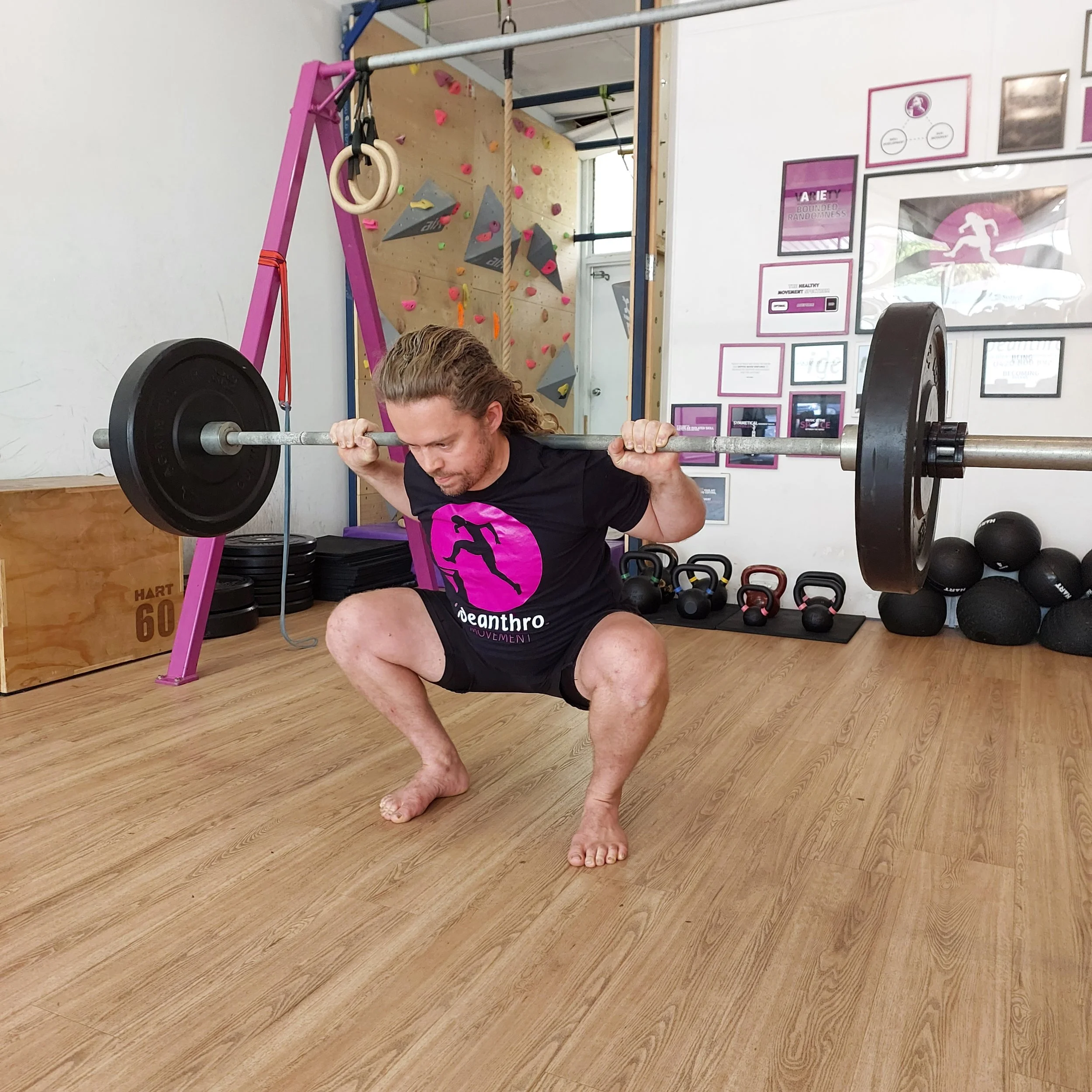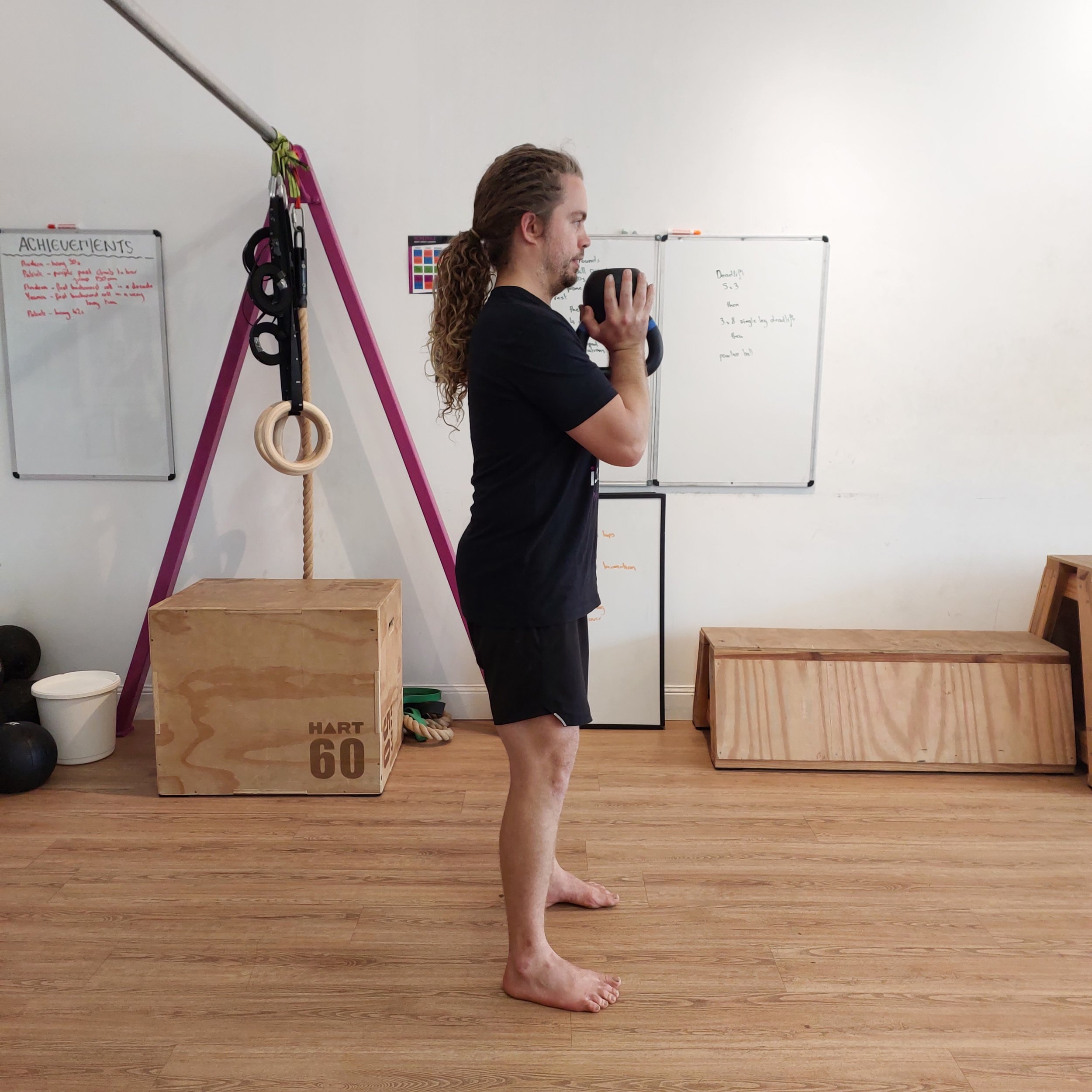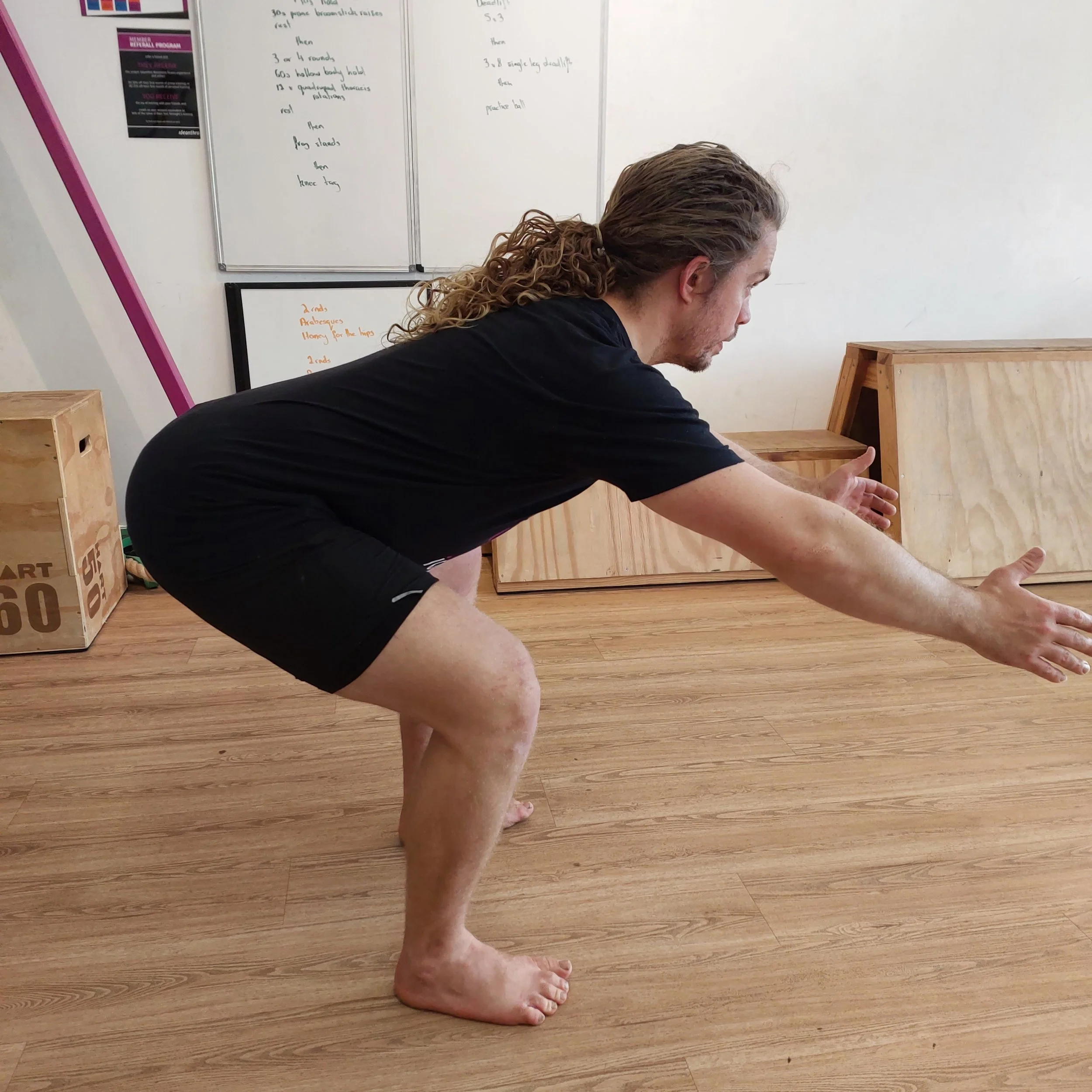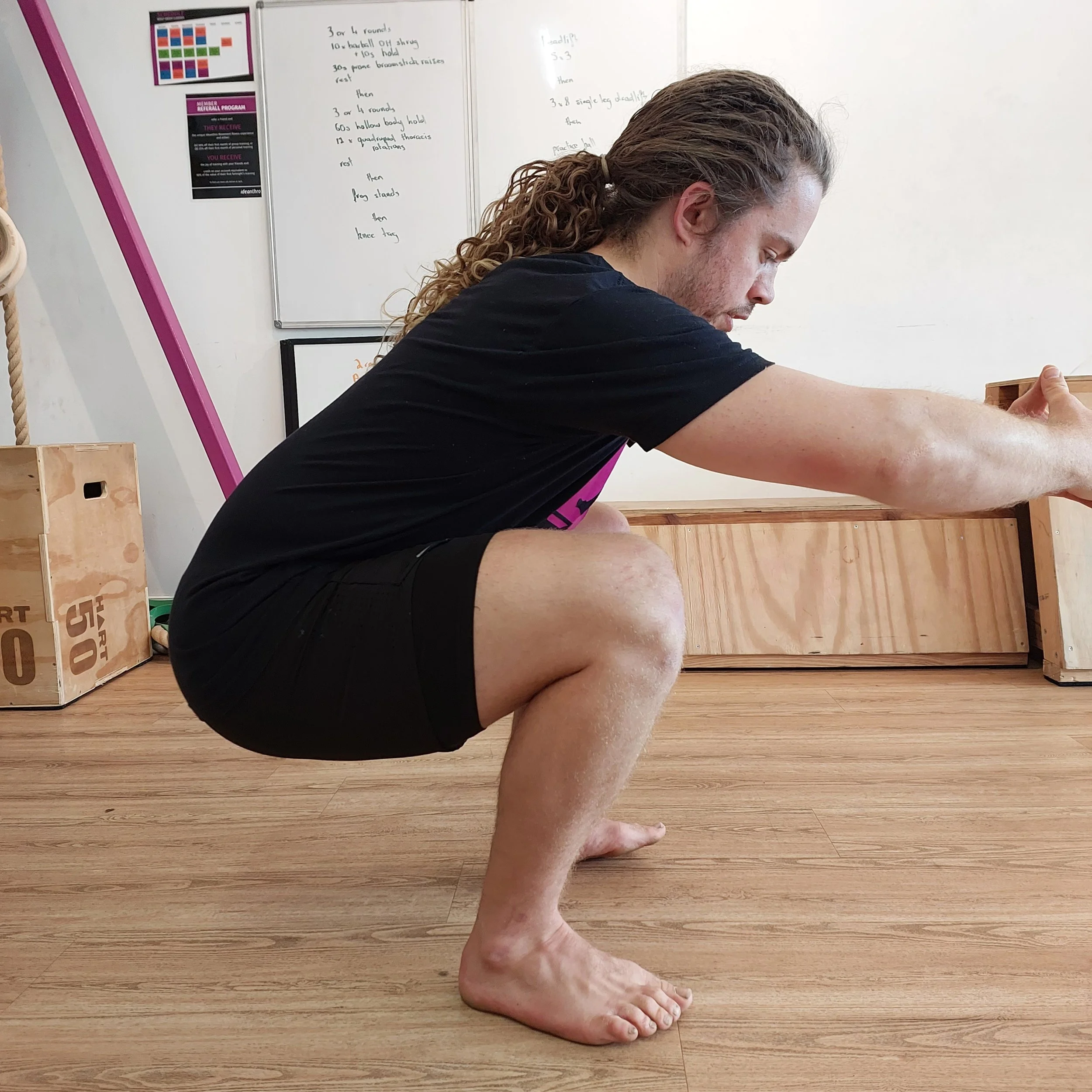3 Tips To Improve your squat
The barbell back squat is one of many types of squat.
You might recognise squatting as a great exercise that people do in the gym, but it's far more than that.
Squatting is a fundamental human movement.
If you have ever...
got up and down from the floor,
helped a child tie their shoes,
tied your own shoes without a seat or step to sit on,
picked up a large and heavy object from the floor, or
crouched down to get something out of a low cupboard...
...then you've probably squatted. It might not have looked exactly like the classic squat that you see in the gym, but it was still a squat.
Squatting allows us to reach underneath and then lift a large heavy object.
Squatting on the balls of our feet helps us access low cupboards.
A split squat is a useful position from which to tie our shoes.
Squatting is everywhere, so it pays to get good at it.
In this post we'll share with you 3 tips to improve your squat. They won't give you the perfect squat all on their own, and ultimately my squat will always look a little different to your squat simply because body proportions play a massive role in squatting, but they'll take you a long way in the right direction for relatively little effort.
TIP 1 - Knees in line with feet
A common error that many of us will make when we first start squatting is to have your knees come too close to each other during the squat. It's like we temporarily become a little bit knock kneed as we squat.
What we want is for our knees to track in line with our toes as we squat.
A shallow squat with knees in line with toes. A good position!
A shallow squat with knees caving inwards. Not ideal for your knees!
The reason this is important is knee health. The knee is essentially a hinge joint. It primarily wants to move in one direction. Yes, it can rotate a little in other ways, but it's not what it really wants. When we allow our knees to track towards each other our knees bend in a way that they don't love!
Here’s how you start to keep your knees tracking in line with you toes:
1) Feet shoulder width apart. That's probably slightly wider than your normal stance.
2) Feet close to straight. You don't want them dead straight like standing on train tracks, but nor do you want them pointed out like a duck!
3) Weight evenly distributed between (a) the ball of the foot behind the big toe, (b) the outside edge of the foot, and (c) the heel.
4) As you squat, maintain points 1, 2 and 3 while keeping your knees tracking in line with your toes. This will likely feel like you need to push your knees outwards more than you currently do.
Tip 2 - Hips back!
Try this for me.
Do a squat that's comfortable for you and pay attention to which part of your body initiates the movement.
Which body part moves first?
If you are like many other people, then when you first start consciously practicing squats, the first movement in your squat will come from your knees. They will move forward, and then continue to move forward as you descend. At a certain point, you'll feel that you can't go any lower without lifting your heels off the ground. It looks like this.
Standing to start
The knees move first and the torso shifts forwards. Excessive weight shifts onto the toes.
The knees have moved are far forwards as possible without the heels lifting.
The heels are forced to lift to continue descending.
Contrary to popular fitness industry opinion, squatting with your heels raised off the ground is not necessarily a problem. But it is a problem if that's the only way you can squat. Some squats should be performed with your heels off the ground.
If I'm squatting down to get something out of the cupboard, that is much easier done with my heels in the air.
On the other hand, if I'm squatting down to pick up a heavy object, that's best done with my heels on the ground.
Squatting with heels raised when accessing a low cupboard.
Squatting with heels on the ground to pick up a heavy object.
And if I want to get into a deep squat with my heels on the ground, I need to learn not to start the movement by bending my knees.
The way we learn to do this is by deliberately starting the movement by pushing our hips back a little bit. Don't get me wrong, in the long term we want to start the movement with a simultaneous movement of both the hips and knees, but for the time being, while you're learning not to start the movement with your knees, we're going to go in completely the opposite direction and move our hips first.
It goes like this:
1) Start standing
2) Push your hips back a little bit, accompanied by leaning forward sightly
3) From here, descend by bending both the hips and knees simultaneously
Standing to start.
The hips move back first. This is accompanied by a slight forward lean.
Descending by bending at both the knees and hips.
A nice depth is reached with heels on the ground.
If you do this correctly, you will almost certainly immediately be able to squat lower than you could when you initiated the movement with your knees.
Over time, once you are comfortable with moving the hips first, you should adjust the movement to initiate your squat at the hips and knees simultaneously.
Tip 3 - Ankle mobility matters
When you squat do you feel like you have to bend forward a long way?
Do you feel like you can't stay as upright or squat as low to the ground as everyone else?
Does your squat look like this?
Your ankles might be the problem
I know it can sound weird that your ankles might be the problem, but hear me out.
Have a look at this photo. In it you can see that the front of my knee is in front of my toes. This is a hallmark of a quality deep squat.
I know that you might have been told that squatting with your knees over your toes is bad for your knees, but that is a myth. With the right technique and mobility it's totally fine. In fact knees coming in front of toes towards the bottom of a deep squat is a critical feature of that squat. Let me show you why.
In the next two photos sequences I start in a deep squat and then pretend that I don't have flexible ankles. To do this, I move my knees back to in line with my toes. When I do this, one of either two things happens.
If, as I shift my knees backwards, I stay low in the squat, then I fall over. Shifting my knees backwards shifts my whole centre of mass backwards such that it is no longer over my feet. Then I fall.
A deep squat. Knees are in front of toes.
As I move my knees backwards, pretending that I have tight ankles, my centre of mass shifts towards my heels.
Eventually I can no longer balance and I fall backwards.
If I don't want to fall then the other option is to raise my hips. If I do that then I keep my centre of mass above my feet. I don't fall, but I do end up bent forwards much further.
This might look / feel familiar to you.
Another deep squat, again with knees in front of toes.
As my knees move backwards, my hips raise and my torso tilts forwards to maintain my centre of mass over my feet.
In this position it might feel that my hips are too tight to squat deeper (and they could be), but don't forget to check if the problem is your ankles.
If you’d like to know more about how to improve you ankle mobility in ways that will help your squat then check out this post.
OTHER TYPES OF SQUATS
So far almost all the photos we have shown you related to a typical flat footed squat with your feet in a line that you might see in the gym. But there are many other different types of squat.
You might be wondering, "Will these tips help with those squats as well?"
Yes, for the most part they will.
Even though some squats look quite different to others, the fundamental principles still apply. As an example, let's look at a split squat (similar to the position you might adopt to tie your shoes).
Split squat. Front view.
Split squat. Side view.
Are my knees in line with my toes?
Yes. See the difference between these two photos.
A split squat with knees in line with toes.
A split squat with the front knee (in particular) caving inwards.
Have I moved my hips back to begin the movement?
You can't tell from the photo, but the answer is no. However, remember that in some squats it's ok for the heels to raise off the floor, and in that case, there is likely to be less hip movement required. A split squat like this is one of those cases.
Are my ankles sufficiently mobile for the squat I’m performing?
Yes. In this squat I maintain an upright posture, indicating that my ankles were sufficiently mobile for the movement. Note also that a split squat requires less ankle mobility that the flat footed squats that you might be using to lift weights in the gym.
Want help with your squat?
We help people of all ages and abilities to improve their squat, both for athletic performance, but just as importantly, to keep ourselves fit and active in daily life. If you'd like to know more then click below to book a free consultation
Our programs
our group classes
STRENGTH AND MOVEMENT
Develop the fundamentals and then master a wide range of strength and movement skills in our strength and movement class. Utilising a variety of weightlifting and bodyweight techniques to create a solid workout and develop full body strength. Move through life with confidence.
BODYWEIGHT
Strength and flexibility training using only your own body weight. Designed to balance and fortify the foundation of your body. Inspired by gymnastics, callisthenics and hand balancing, learn how to control your most trusty tool – your own body.
NATURAL MOVEMENT
Become stronger and more mobile by training practical movement skills. Designed with a strong focus on skill development, our natural movement classes have a playful and creative streak within.
NATURAL MOVEMENT LITE
Learn the core movement skills of our natural movement class at a more sedate pace. Perfect for anyone wanting a gentle approach to training, or with a desire to master the basics of natural movement. This class is particularly popular with our members in their 50’s, 60’s and 70’s, but you’re welcome to attend no matter your age.





































